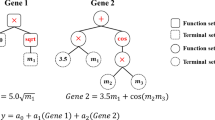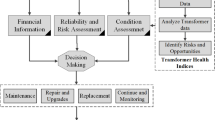Abstract
The present paper deals with modeling of AC resistance of twisted litz wires used for high-frequency inverter-fed induction cooker. Several traditional approaches are available, most of which have concentrated in deriving the analytical relationships between the AC resistances with the parameters of the wire. However, it is very difficult to get the exact relationship, due to several reasons. An attempt is made in this paper to model the AC resistance using a three-layered feed-forward Neural Network. For this purpose, four inputs (wire type, number of strand, number of spiral turn and operating frequency) and one output as AC resistance have been considered. Since the performance of Neural Network alone might not be optimal; it is optimized using a binary-coded Genetic Algorithm. Performances of the proposed approach were compared with the method of AC resistance computation proposed by Ferreira. Genetic-neural system has given a very close accuracy, and the computational complexity was found to be very low. Thus, it is suitable for online implementations.








Similar content being viewed by others
References
Koertzen HWE, VanWyk JD, Ferreira JA (1992) An investigation of the analytical computation of inductance and ac resistance of heat-coil for induction cookers. Ind Appl Soc Annu Meet 1:1113–1119
Lotfi AW, Lee FC (1993) A high frequency model for litz wire for switch mode magnetic. IAS Annu Meet 2:1169–1175
Dowell PL (1966) Effects of eddy currents in transformer winding. Proc Inst Elect Eng 113:1387–1394
Perry MP (1979) Multiple layer series connected winding connected winding design for minimum losses. IEEE Trans Power Appl Syst PAS-98:116–123
Bennet E, Larson SC (1988) Effective resistance of alternating currents of multi layer winding. Trans Amer Inst Elect Eng 3:266–276
Ferreira JA (1989) Electromagnetic modeling of power electronic converters. Kluwer, Boston
Ferreira JA (1994) Improved analytical modeling of conductive losses in magnetic components. IEEE Trans Power Electron 9:127–131
Bertoli M, Noferi N, Reatti A, Kazimierczuk MK (1996) Modeling winding losses in high frequency power inductors. World Sci J Circ Syst Comput (Special issue on Power Electronics, Part II) 5:607–626
Murgatroyd PN (1989) Calculation of proximity losses in multi stranded conductor bunches. IEE Proc A 136(2):115–120
Cheng KWE (2000) Computation of ac resistance of multi stranded conductor inductors with multi layers for high frequency switching converters. IEEE Trans Magn 36(4):831–834
Nan X, Sullivan CR (2003) An improved calculation of proximity effect loss in high frequency windings of round conductors. IEEE Power Electron Specialists Conf 2:853–860
Nan X, Sullivan CR (2005) A two-dimensional equivalent complex permeability model for round wire windings. IEEE Power Electron Specialists Conf 613–618
Hu J, Sullivan CR (1998) Optimization of shapes for round wire high frequency gapped inductor windings. IEEE Ind Appl Soc Annu Meet 2:907–911
Tourkhani F, Viarouge P (2001) Accurate analytical model of winding losses in round litz wire windings. IEEE Trans Magn 37(1):538–543
Podoltsev AD, Kucheryavaya IN, Lebedev BB (2003) Analysis of effective resistance and eddy current losses in multi-turn winding of high frequency magnetic components. IEEE Trans Magn 39(1):539–548
Pratihar DK (2009) Soft computing. Narosa Publishing House, India
Acknowledgments
The authors are profoundly grateful to the anonymous reviewers, whose suggestions helped a lot to improve the quality of the paper.
Author information
Authors and Affiliations
Corresponding author
Rights and permissions
About this article
Cite this article
Sinha, D., Sadhu, P.K., Pal, N. et al. Genetic neural-based modeling of AC resistance of heating coil used for high-frequency inverter-fed induction cooker. Neural Comput & Applic 22, 1379–1386 (2013). https://doi.org/10.1007/s00521-012-0822-8
Received:
Accepted:
Published:
Issue Date:
DOI: https://doi.org/10.1007/s00521-012-0822-8




